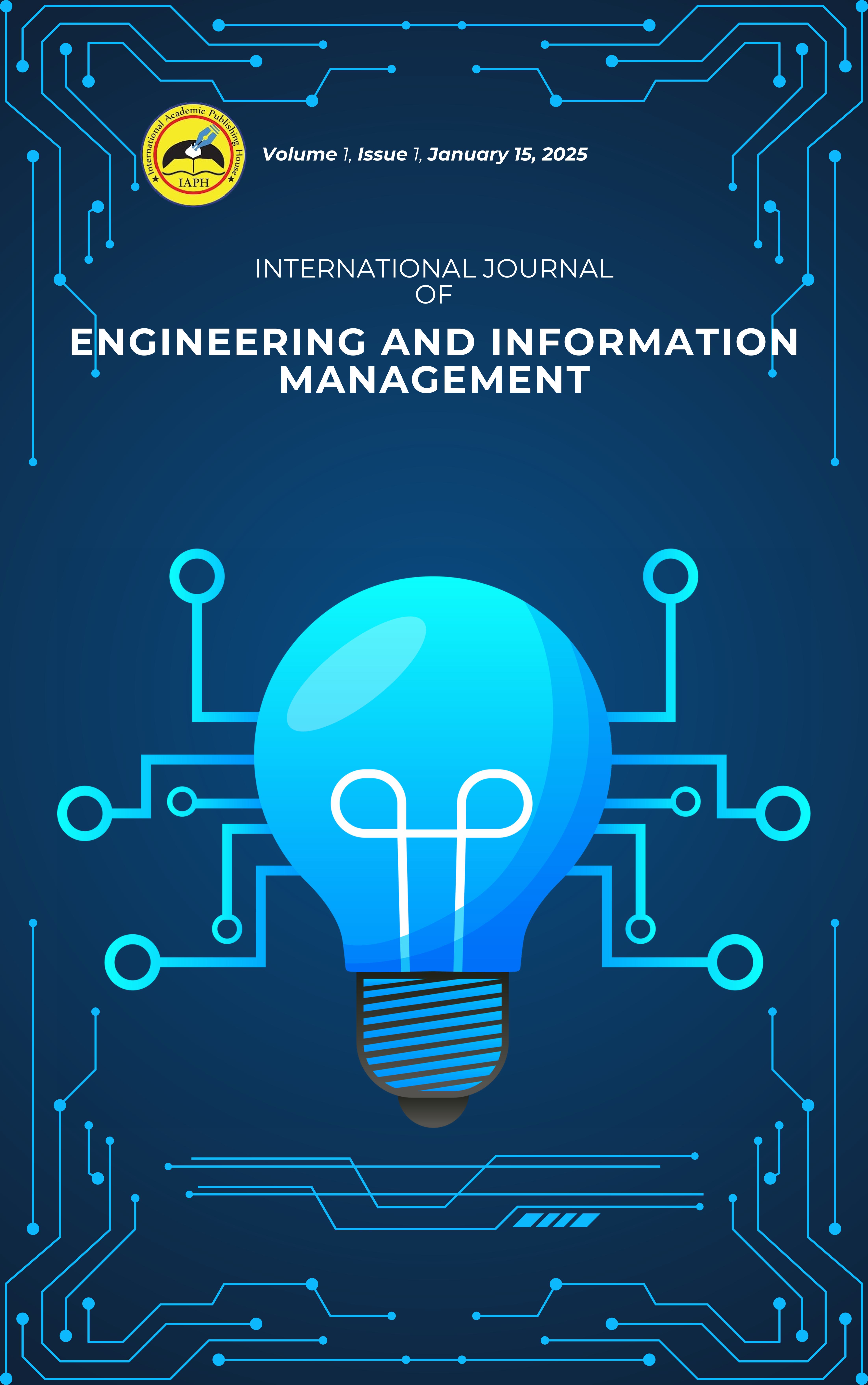Efficient Image Synchronization and Change Detection Using XOR-Based PATCH Algorithms in Digital Twin Technology
Keywords:
Change Detection of Image, Digital Twin, Image Processing, XOR operationsAbstract
This paper proposes an efficient XOR-based PATCH algorithm for real-time image synchronization and change detection in Digital Twin Technology. The primary objective is to minimize computational overhead, memory usage, and bandwidth by transmitting only pixel-level changes (PATCH) between physical and digital twins rather than entire image datasets. The proposed algorithm demonstrates versatility by effectively handling black and white, greyscale, and coloured images. Ex- tensions of the algorithm for greyscale and coloured images involve applying XOR operations across intensity levels and RGB channels, respectively, ensuring minimal storage requirements while maintaining synchronization accuracy. Experimental results show that the algorithm scales linearly with image size, significantly improving bandwidth and memory efficiency, particularly in high-resolution images with sparse changes. The scalability and adaptability of the XOR-based PATCH algorithm make it highly suitable for real-time applications in resource-constrained environments, such as IoT-based remote monitoring systems.
Downloads
References
Arbelaez, P., Maire, M., Fowlkes, C., and Malik, J. (2011). Contour detection and hierarchical image segmentation. IEEE Transactions on Pattern Analysis and Machine Intelligence, 33(5), 898–916. https://doi.org/10.1109/TPAMI.2010.161.
Bankins, S., Ocampo, A. C., Marrone, M., Restubog, S. L. D., and Woo, S. E. (2023). A multilevel review of artificial intelligence in organizations: Implications for organizational behavior research and practice. Wiley, 45(2), 159–182. https://doi.org/10.1002/job.2735.
Bansal, A. (2020). Image encryption and decryption algorithm using xor operator. International Journal of Computer Science, 12(4), 45–49. https://doi.org/10.48175/568.
Brown, J. and Taylor, M. (2022). Change detection in digital twins using machine learning. Pattern Recognition Letters, 155, 53–60. .
Diskin, Y., Asari, V., Hytla, P., and Vasquez, J. (2014). Illumination invariant 3D change detection. In Proceedings of SPIE, the International Society for Optical Engineering, volume 9024, page 90240D. https://doi.org/10.1117/12.2041038.
Fuller, A., Fan, Z., Day, C., and Barlow, C. (2020). Digital twin: Enabling technologies, challenges and open research. Institute of Electrical and Electronics Engineers, 8, 108952–108971. https://doi.org/10.1109/access.2020.2998358.
Gupta, A. and Sharma, P. (2021). A survey on machine learning in digital twins. IEEE Access, 9, 109477–109488. Homaei, M. H., Gutierrez, O., Núñez, J. C. S., Vegas, M. , and Caro, A. (2023). A review of digital twins and their application in cybersecurity based on artificial intelligence. 57, 201. https://doi.org/10.1007/s10462-024-10805-3.
Islam, M. R., Subramaniam, M., and Huang, P. C. (2024). Image-based deep learning for smart digital twins: a review. arXiv preprint arXiv:2401.02523. https://doi.org/10.48550/arXiv.2401.02523.
Ko, J. and Kim, R. (2021). Change detection in urban digital twins for smart city management. Urban Planning and Design, 15(2), 75–87.
Krizhevsky, A., Nair, V., and Hinton, G. (2018). CIFAR-10 (Canadian Institute for Advanced Research). http://www. cs. toronto. edu/kriz/cifar. html.
Lamboray, E., Wurmlin, S., and Gross, M. (2004). Real-time streaming of point-based 3D video. In IEEE Virtual Reality Conference, pages 91–281. https://doi.org/10.1109/VR.2004.1310060.
Lee, K. and Park, M. (2022). A survey on secure image transmission techniques for digital twins. Security and Communication Networks, 2022, Article ID 6513458.
Lin, T.-Y., Maire, M., Belongie, S., Hays, J., Perona, P., Ramanan, D., Dollár, P., and Zitnick, C. L. (2014). Microsoft coco: Common objects in context. In Computer Vision–ECCV 2014: 13th European Conference, Zurich, Switzerland, September 6-12, 2014, Proceedings, Part V 13, pages 740–755. Springer. https://doi.org/10.1007/978-3-319-10602-1_48.
Muller, E. (1973). Frame synchronization techniques for digital communication. IEEE Transactions on Communications, 21(1), 31–37.
Patel, S. and Wang, Y. (2022). Deep learning in vision-based digital twins for object recognition and scene reconstruction. Journal of Computer Vision, 42, 385–408.
Pramanik, A., Sarkar, S., and Maiti, J. (2021). A real-time video surveillance system for traffic pre-events detection. Accident Analysis & Prevention, 154(5), 106019. https://doi.org/10.1016/j.aap.2021.106019.
Rajini, K. and Roopa, S. (2017). A review on recent improved image fusion techniques. In 2017 international conference on wireless communications, signal processing and networking (WiSPNET), pages 149–153. IEEE. https://doi.org/10.1109/WiSPNET.2017.8299737.
Sarkar, S., Sammangi, V., Raj, R., Maiti, J., and Mitra, P. (2019). Application of optimized machine learning techniques for prediction of occupational accidents. Computers & Operations Research, 106, 210–224. https://doi.org/10.1016/j.cor.2018.02.021.
Sarkar, S., Vinay, S., Djeddi, C., and Maiti, J. (2022). Classification and pattern extraction of incidents: a deep learning-based approach. Neural Computing and Applications, 34, 14253–14274. https://doi.org/10.1007/s00521-021-06780-3.
Shah, K. and Singh, D. (2021). Image processing in smart cities for digital twins. IEEE Internet of Things Journal, 8(7), 4876–4885.
Smith, G. and Zhao, H. (2021). Image fusion techniques based on optimization algorithms: A review. Optical Engineering, 60(4), 1–16.
Thelen, A., Zhang, X., Fink, O., Lu, Y., Ghosh, S., Youn, B. D., Todd, M. D., Mahadevan, S., Hu, C., and Hu, Z. (2022). A comprehensive review of digital twin - part 1: modeling and twinning enabling technologies. In Springer. https://doi.org/10.1007/s00158-022-03425-4 .
Trauer, J., Schweigert, S., Engel, C., Spreitzer, K., and Zimmermann, M. (2020). What is a digital twin? – definitions and insights from an industrial case study in technical product development. In Cambridge University Press, volume 1, pages 757–766. https://doi.org/10.1017/dsd.2020.15.
Wang, Y., Su, Z., Guo, S., Dai, M., Luan, T. H., and Liu, Y. (2023). A survey on digital twins: Architecture, enabling technologies, security and privacy, and future prospects. IEEE Internet of Things Journal, 10(17), 14965–14987. https://doi.org/10.1109/jiot.2023.3263909
Downloads
Published
Issue
Section
License
Copyright (c) 2025 International Academic Publishing House (IAPH)

This work is licensed under a Creative Commons Attribution-NonCommercial-NoDerivatives 4.0 International License.

